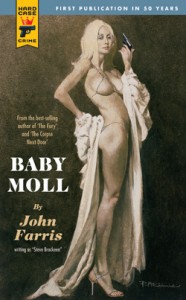 “Baby Moll†by John Farris (using the pen name “Steve Brackeenâ€) is a suspense novel with lots of skill and not much thought. The writing is confident and powerful, but it’s not enough to support a plot that’s artificial and unrewarding. The characters are no help: They taunt the hero, a retired mobster named Pete Mallory, with episodes of crime and sex that aren’t as explosive as they sound. On top of everything, they act and talk with a kind of emphasis that’s almost theatrical, as if they know somebody’s reading about them. They might have a right to, considering the B-movie plot they’re left to work with.
“Baby Moll†by John Farris (using the pen name “Steve Brackeenâ€) is a suspense novel with lots of skill and not much thought. The writing is confident and powerful, but it’s not enough to support a plot that’s artificial and unrewarding. The characters are no help: They taunt the hero, a retired mobster named Pete Mallory, with episodes of crime and sex that aren’t as explosive as they sound. On top of everything, they act and talk with a kind of emphasis that’s almost theatrical, as if they know somebody’s reading about them. They might have a right to, considering the B-movie plot they’re left to work with.
This is another pulp production by Hard Case Crime, which publishes a different book every month. Each of them gets a context-sensitive cover painted for it, all intended as throwbacks to the age of dime novels and hard-boiled noir. Although the company works with a few new writers, a great deal of their novels come from bestselling veterans, Farris included. For nostalgia’s sake, there are old works as well as new ones: “Baby Moll†was first published 50 years ago and it even says so right on the cover, with capital letters.
If you can believe it, even Stephen King wrote a Hard Case Crime novel called “The Colorado Kid.†It’d be wrong to label it as a “suspense novel,†though, particularly since it’s one of the most boring and poorly executed books he’s ever written – even romantic terms like “recommended for fans only†don’t apply to it. His stuff rarely misses, which makes that novel a kind of oddity.
Farris’s novel is more interesting than King’s, but it has the same problem – it wastes great writing on content that doesn’t deserve it. The story follows Mallory on a reluctant mission that forces him out of retirement. His old boss, Macy Barr, is the ringleader of a mob syndicate in Florida: His empire is crumbling, his power is fading and someone wants him dead, which leads him to a desperate bargain with Mallory to find the hit-man.
Mallory might be a typical reluctant hero, but he’s developed much better than the characters he’s surrounded by – mean-eyed mobsters and their pneumatic wives. They chime in whenever the plot gets kind of thin, a job that keeps them busy, busy, busy.
That just leaves Farris’s style, which has its own kind of intelligent power. It’s fascinating to see him work with such unworthy content, as if he were a gifted artist who’s been hired to paint a car. He makes the most of it with colorful descriptions of people and places that wait for something interesting to happen, which is about as suspenseful as this book gets. It’s odd, though, how Farris sets up different places with careful attention to detail, only to abandon them once they’ve made themselves useful. Like the part where a tip leads Mallory to a bar: Why bother to mention the dimpled linoleum floor and the mute jukebox (and so forth) if he never goes there again?
Remember, though, that this is a book Farris wrote years ago – his talent has probably grown since then. For him, “Baby Moll†might be a fuzzy memory, one he’d surely rather forget. The people at Hard Case Crime opened old wounds by giving it a new edition, complete with a new blurb that tells us that “No man escapes the sins of his past.†Maybe they were rubbing it in.

Leave a Reply